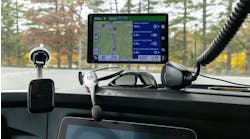NASHVILLE—Lytx has introduced a suite of tools geared to help drivers take back control of their own performance. The tools, available now on the Lytx Driver App, are designed so drivers can track and improve their on-road performance with minimal fleet manager input or intervention.
“In the past, it’s been a coaching-centric model where you have that interaction with a supervisor. Now, that interaction still happens, but we’re augmenting it with interactions that happen in the cab,” Alex Jensen, Lytx’s senior content strategist, told FleetOwner during ATA’s 2021 Management Conference & Exhibition here. “The technology is alerting the driver to risks that happen in real-time, and they chose what to do.
“If they extinguish the behavior, the behavior doesn’t go to the manager for an interaction,” she added. “The technology is flowing toward putting the control in the drivers’ hands.”
Available features in the Lytx Driver App include:
- Video: Recorded by Lytx DriveCam Event Recorders, a scrolling feed of video clips provides an overview of past trips.
- Self-coaching: Leveraging video-playback capabilities, drivers can track their performances and focus on improvement where they need it.
- Performance metrics: Drivers can access performance trends over a 90-day period, which gives them the ability to track their progress, address new risks, and celebrate improvements, according to Lytx.
- Driver recognition: The app also allows drivers to compare their performance to others, and managers can use the data to set up recognition programs based on safety performance.
- Route risk: This feature helps drivers avoid or manage potential roadway hazards. It alerts drivers to slowing traffic, crashes, inclement weather, pedestrian crossings, children playing, wildlife crossings, and other potential dangers.
- ELD compliance: Drivers can record ELD hours-of-service status and complete vehicle inspections from their tablets or smartphones.
- Driver ID: Drivers can access an individualized QR code along with instructions on how to scan it, eliminating the need to carry and manually scan a physical badge.
“We learned especially through COVID that now we have more of a remote society, and our clients have to approach their driver workforce the same way,” Gary Johnson, director of safety services for Lytx, explained. “This is a tool to help them manage and stay connected with their drivers.”
Through engagements with fleet customers, Lytx has found that fleets are most concerned about driver behavior modification, as well as rewarding and recognizing good behaviors. In addition, through machine vision and artificial intelligence, Lytx can monitor in-cab behaviors via interior sensors without video for those sensitive to driver-facing cameras. Fleets can utilize the sensor within the event recorder to determine whether a driver is distracted or inattentive.
“The whole idea is you want an outcome of safer driving, it’s not to punish the driver,” Jensen said. “What we found affects outcome is accuracy and specificity. The first thing is drivers will start to ignore the alerts if they feel they are not accurate, especially if it’s constantly a false alarm.”
Alert fatigue is something that everyone in the industry has to be aware of, Johnson noted.
“Through my history with early technology, there was a lot of it,” Johnson pointed out. “So, after a while, you become numb to it. The system really allows the correction, so it’s not going to constantly address that behavior every time. It will actually utilize the data and give the driver a reminder of the behavior if it happens a second time and then it will rest and continue to watch the driver to see if that behavior continues. It will typically learn the driver behavior and then deliver notifications.
“We try to be really sensitive not to give the alert fatigue, but we give them reminders when they are needed in the cab and then send it for coaching if the behavior continues,” Johnson added.




